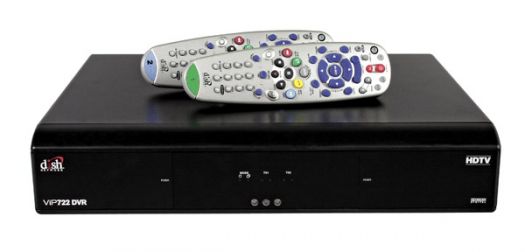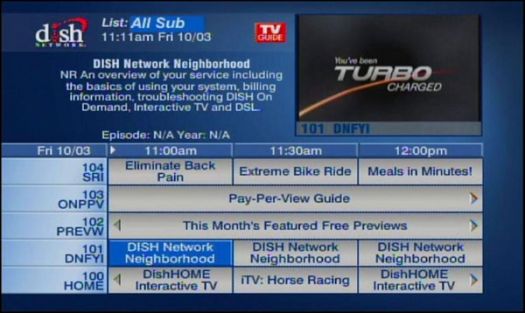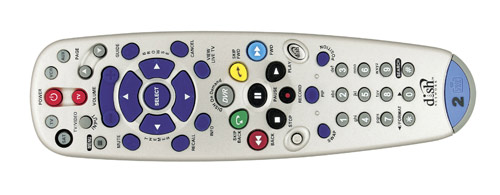Give The People What They Want
Do you remember being a kid, when you discovered that magic glowing window that spat out all your favorite cartoons, and then all you wanted to do was sit there and stare at it all day until your eyeballs crusted over? I sure do, like it was yesterday. My new hero, Guinness record holder Suresh Joachim, obviously understands. Well, my humble dreams might have evolved somewhat (the occasional movie helps break up the monotony of Bugs and Daffy) but my passion has been born again with the arrival of the DISH Network ViP722 High Definition DVR (Digital Video Recorder).
The ViP722 is a three-tuner satellite receiver (2 satellite, one OTA) with a 500-gigabyte hard disk drive inside, enabling the viewing and/or concurrent recording of two satellite feeds (HD or SD), plus the signal from an over-the-air ATSC digital broadcast. This last feature is not only a high-value bonus of the ViP722, it also helps when a customer's local channels are unavailable as part of his DISH Network programming package, as is sometimes the case.
Depending upon distance from the nearest TV broadcast tower, an indoor or outdoor UHF/VHF antenna should do the trick, delivering HD-quality local programming for free. For this review, we installed a Terrestrial Digital Outdoor antenna, Model SR15, which worked extremely well to pull in digital channels from the Empire State Building roughly 25 miles away.

Three tuners might sound like a lot to be at the disposal of a single TV, but the ViP722 can also dedicate one of its satellite tuners to serve a second, standard-def TV, not with the use of a secondary box but over the internal cabling of the home. Rancho Chiarella came extensively wired with RF/coaxial, plus we had some more run when we went with DirecTV several years ago, but DISH's installers or a third-party contractor can run cable as needed. High-definition content is automatically transcoded for the second, SD display.
Beyond the tuner trio, which also enables versatile Picture-In-Picture, the box can also grab additional programming over a broadband internet connection. For a mere 99 cents added to my monthly bill I was able to download and view (but not keep) the previous week's episode of 30 Rock, which I had missed. Locating it, completing the transaction and waiting for the SD-quality file to appear only took a few minutes.
The ViP722 unlocks a whole new world of Pay-Per-View options in fact, most notably DISH's much-touted "TurboHD" service, whereby one featured title each month is offered in full 1080p resolution. TurboHD movies, like all DISH content, take advantage of the efficient MPEG-4 codec to for superior quality despite the digital compression necessary to enable the beaming of all those channels over their finite bandwidth. As available, video content is accompanied by a Dolby Digital 5.1 soundtrack.
"I Didn't Even Know I Wanted That!"
In trying to wrap my head around all of the clever little features of the ViP722, I'm reminded of a heavily publicized PC operating system which I reviewed a couple of years ago, brimming with so many innovations big and small that I could only hit the highlights before starting to sound like I was dictating a shopping list. The sheer expanse of the ViP722's functionality, just a click away, ideally requires time to just live with it and learn by hands-on experience. Every little convenience and feature is well-intentioned although there are likely some we may never discover, or use.
Even when the box is "off," it cycles through quick little help driblets on the TV screen, sharing secret shortcuts, telling how many PPV movies are currently available, the number of shows scheduled to record that day, or how many programs I have patiently waiting for me on the DVR. Imagine how helpful (and complex) it is once we turn it on?
To his credit, the DISH installer talked me through what he believed to be the most important tips and tricks for daily use. I spend hours with the ViP722 almost every day, and as the family IT guy, I also field questions from my wife, echoing some of her frustration at the learning curve of the user interface, particularly the layers of screens we had to navigate to do what we wanted.
Recording is a big deal, obviously, but the default option when selecting programs is "All Episodes," which is never what I want. (I tend to be more of a "New Episodes" or "Once" kind of guy.) I repeatedly clicked on this by mistake and had to either go through and remove all of the airings I did not want or I had to delete the planned recordings entirely and start over. This was more of a chore when we were new to DISH Network and didn't really know what we were doing, although I still can't say that we're fans of the official term "Timer" for a recording, or series of grouped recordings.

We can also record manually, VCR-style, which is handy if a show is scheduled to start after a ballgame for example, which could run long. Sadly, science has not figured out a way to automatically extend recording when sports are running late like that. [editor's note: you can schedule any timer event to start early or to end late when you first schedule a recording - this is something we always do for things like the Oscars or any regular show that runs on Sunday nights after a football game].
One happy advantage with DISH is that we can search for upcoming programs using any word in the title, whereas my old TiVo keyed off of the first word, a problem if I wasn't sure of the full, exact name. The ViP722 is also quite good at managing Priority, and warning us in advance if there is a scheduling conflict. Yes, shortages can occur even with three tuners, if you are the type who sets programs to start early and end late to be safe, particularly on crowded nights like Thursday. A subtle but unmistakable two-minute countdown clock also appears when the tuner currently in use is scheduled to switch over to begin recording.
The DISH program guide can extend as many as nine days into the future, and is included free with the service. One of the details that I really commend DISH for is the ability to sort channels in a number of different ways, including a list representing specifically those channels that we actually receive as part of our monthly package. With my previous gear and service, too often I'd be searching and I'd stumble across a listing for an interesting program, only to find that it was airing on a station that I couldn't receive. The 30-second Commercial Skip button is also a permanent fixture on the DISH remote, whereas it was a hush-hush Easter egg on my TiVo, which needed to be reprogrammed every time it lost power.
Lookin' Sharp
At the high end of the ViP722's settings are 720p and 1080i resolution, "HD" technically but in my estimation I'd peg the video quality closer to what I might get off of a maximized 480p presentation of a well-mastered DVD. Admittedly the quality does vary from channel to channel, with premium channels getting more bandwidth (and looking better) than some of the basic channels. Colors in general have an extremely natural richness, overall clarity is excellent, and standard-def immediately seems light years behind, mushy and unpleasant. All I need do is toggle between two consecutive channels--the SD and the HD feeds of many are positioned back-to-back--and apart from the obvious vertical black bars on the sides, the difference is striking, most notably the step down in sharpness.
Even in HD there are eventual challenges like smoke, fine details are not immune from compression artifacting, and I saw some smearing in fast motion. The quality of the video masters surely affects the results too, especially at such high broadcast standards. Not surprisingly, the sharp lines and bright lights of professional sports, captured with the latest, fanciest and most expensive cameras, look particularly great in HD. Also, with its lower compression, programming from the ATSC (over the air) tuner looks noticeably better than comparable channels over the satellite feed. Turn on any late night talk show on a major network, flip between the satellite and OTA versions of an HD channel and you'll see what I mean.
And then of course, there's DISH Network's piece de resistance: TurboHD. At full 1080p, films presented in TurboHD are simply gorgeous. My wife had never seen The Dark Knight before, and she quickly let loose a "Wow…" at the sumptuous level of palpable detail. Even fast-motion was smooth, without significant loss of quality. Blacks are not quite perfect and there is occasional artifacting on soft edges, some strobing on pinstripes and such, but I would agree that TurboHD is indeed within the realm of Blu-ray, as advertised. DISH is clearly allocating some much-needed bandwidth to its 1080p content, and it shows. Of course, the movie was presented at a 16:9-screen-filling 1.78:1 aspect ratio, not the full-wide 2.40:1 of the Dark Knight Blu-ray. The audio was Dolby Digital, which was fine, sometimes outstanding, as it is on most of the non-PPV HD movies I've been watching.

With TurboHD as with other PPV offerings on DISH, once we start the movie, we have 24 hours to do what we will with it. As happens, I was interrupted several times, but found it tricky to locate and start again upon my return. Frankly I would have expected it to be more proactive during that rental window, with a prominent, "Ready to resume?" pop-up or something.
When you initially select a 1080p TurboHD PPV title, the system warns of a possible 15-second blackout as it tests our connected TV for 1080p compliance, but for me the movie began playing--and I could also fast forward all the way to the end--immediately. My best guess is that DISH covertly pushes the featured title to people's boxes, in an effort to impress with their entire TurboHD initiative. A certain portion of the ViP722's hard drive is allocated for "internal use" and this must be one of those uses. The box is clearly 1080p capable, and when more programming is available at that resolution, ViP722 owners will be ready. In the meantime, DISH has a knack for picking TurboHD titles that will excite, such as Iron Man the month before and more recently Eagle Eye.
Meanwhile, Upstairs…
A trusty old tube television in the bedroom was the beneficiary of the ViP722's secondary TV support. The TV2 remote looks virtually identical to the first, except of course it has a "2" printed on the blue rubber at the bottom. It is a four-component, universal-type utilizing UHF Pro dual-frequency RF, since it will likely have to work through walls in order for its commands to reach the small RF antenna on the box, installed elsewhere. A "Mode" button hidden behind a door on the front panel of the unit toggles between Single and Dual. In Single Mode, the second TV is essentially a mirror of the first, displaying the same content although the remote in either location can control it, with full Picture-In-Picture functionality.

In Dual Mode, separate programs can be viewed, recorded or played back on the two TVs. We were able to watch the same recording at both locations and control it independently, as when I paused it upstairs while it continued playing downstairs. All I seem to have lost in this Dual Mode was P-I-P, since the tuners were otherwise occupied, and access to the ATSC antenna feed, which no longer appeared in the program guide listing. Not surprisingly, the HD signal when downconverted to SD delivers a superior picture compared to simply watching the same program in straight SD. The only "problem" I encountered was laughable: I leave my audio receiver on almost constantly, even when the HDTV is off, so it's weird to suddenly hear last night's Biggest Loser playing in a dark home theater, as it's being viewed off in the bedroom.
Space, The Final Frontier
The process of supplementing the storage of the ViP722 has been designed to be almost as simple as plug-and-play. For a one-time setup fee of $39.99, we can connect our own third-party USB 2.0 hard disk drive, meaning we can drastically expand our recording capacity. This can potentially solving a dilemma that has plagued DVR owners since the early days - what to do when you fall so far behind in your TV watching that your DVR fills up. If you like you can even create a catalog of high definition movies or multiple seasons of TV shows on your external hard drive, and when that fills up, plug in a new one for effectively unlimited storage capacity. When you want to watch something you recorded on the first drive, simply plug that original HDD back into any compatible receiver (within your household) and go to town.
There are certain hardware restrictions: it must have a separate AC power supply, no flash storage, no dual-disk drives, no, optical-plus-flash "hybrid" drives. And in truth, after a couple of misses I was still searching for a compatible HDD at press time, and I'm planning to update this review when I succeed. In the meantime, I am disappointed to report that there's no "Save to VCR" option here as on my retired TiVo, for offloading and potentially sharing recorded content via an external VCR or DVD recorder.
UPDATE (5/6/09):
Finally! Seagate let us try out their new one-terabyte (1,000 gigabytes) Showcase DVR Storage Expander freestanding hard disk drive, which quickly plugs into AC power and USB before being immediately recognized by the receiver. After two click-through screens warning that the drive would be reformatted (and erased) and the receiver would reboot, I just walked away for about three minutes, and then another three for the full system restart. A "My Media" folder now appeared at the top of the DVR sub-menu, boasting a formatted size of 930 gigabytes, roughly tripling my effective capacity. The ViP722 provides simple onscreen instructions on how to move content between itself and the USB device--and back again--so simple in fact that I found myself offloading/archiving about six HD hours of seldom-watched children's holiday programming onto the Seagate drive, a process estimated at an hour and 20 minutes of wait time but it actually took less, during which I could switch back and watch live TV.
Turn-Ons:
Turn-Offs:
Final Thoughts
The comprehensive "America's Everything Pak" package of programming that we used in this evaluation is currently priced at a reasonable $97.98/month for close to 300 channels including locals, loads of premium channels and a generous amount of high definition channels. DISH's entry-level HD bundle however is a mere $19.99/month (not including the DVR fee, should you choose a DVR). There are also a number of promotions and trial offers available to bring prices down even further, and you can connect a second TV to the DVR at no additional cost.
For me, the combination of one of their most versatile boxes ever with their strongest programming lineup, including some premium content in 1080p, is a profound revelation akin to my first encounter with TV itself, decades ago. The magic window has grown bigger and brighter since then, and oh, the bounty it can now deliver.
DISH Network Sign-up Offer:
Specifications from the Manufacturer:
Manufacturer's Contact Details:
DISHNetwork - Echostar
5701 South Santa Fe Drive
Littleton, CO 80120
Web: http://www.dishnetwork.com/
| Overall | |
|---|---|
| Value | |
| Performance | |
| Features/Ergonomics |